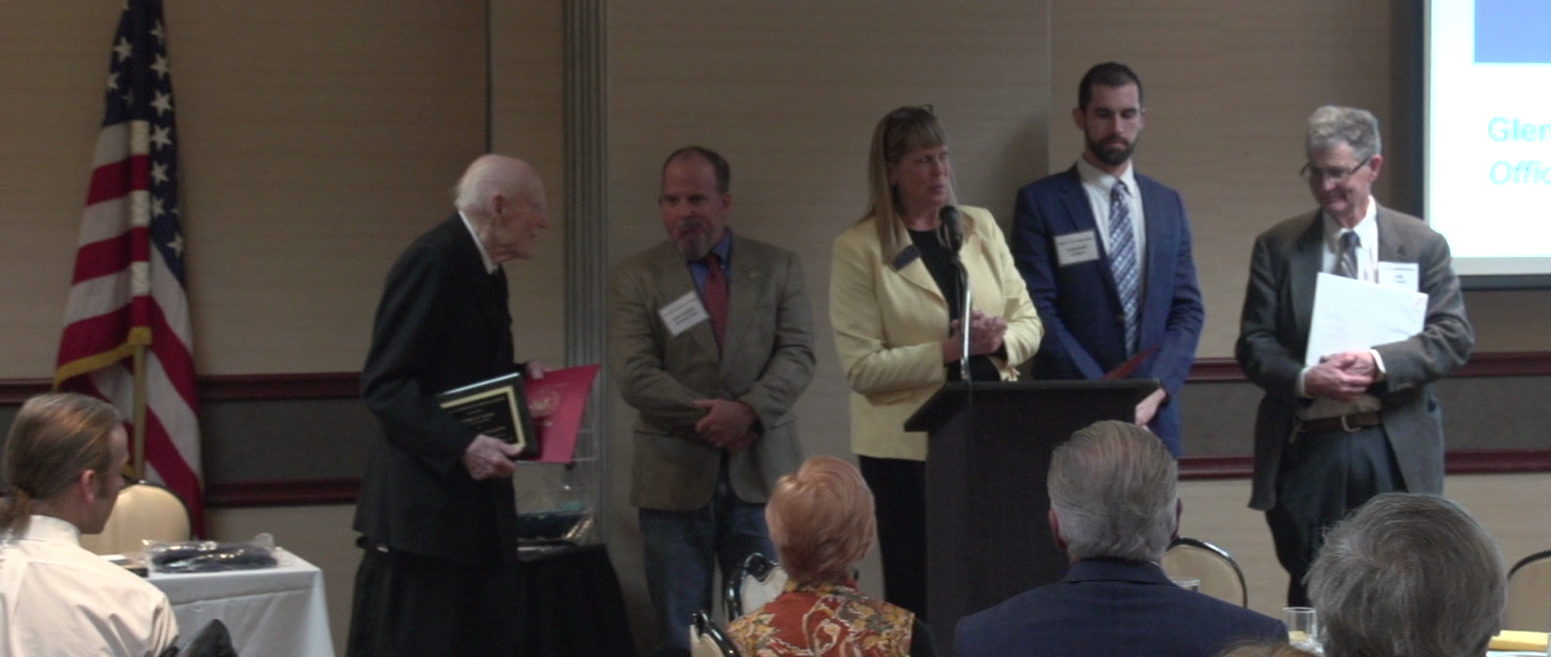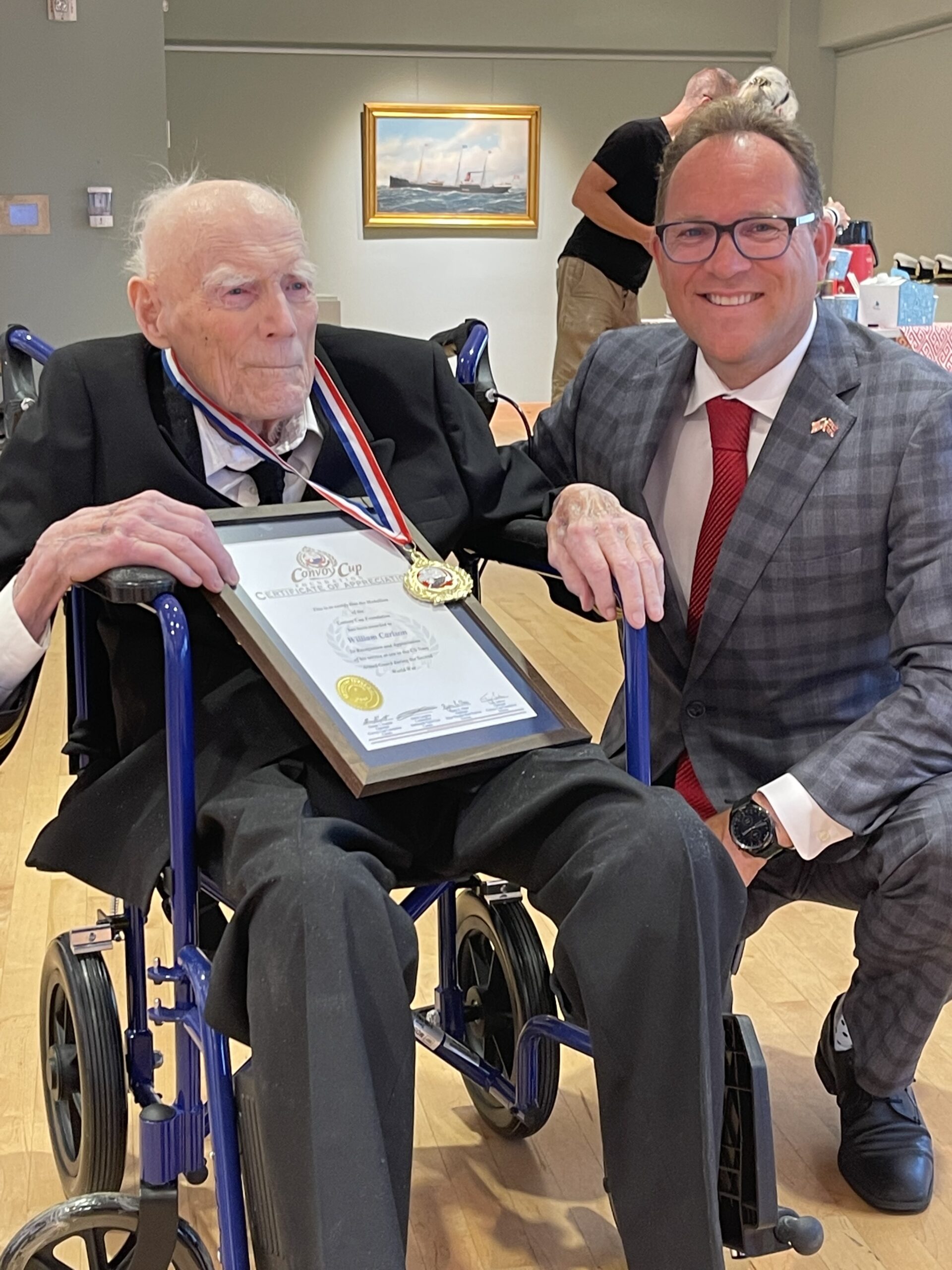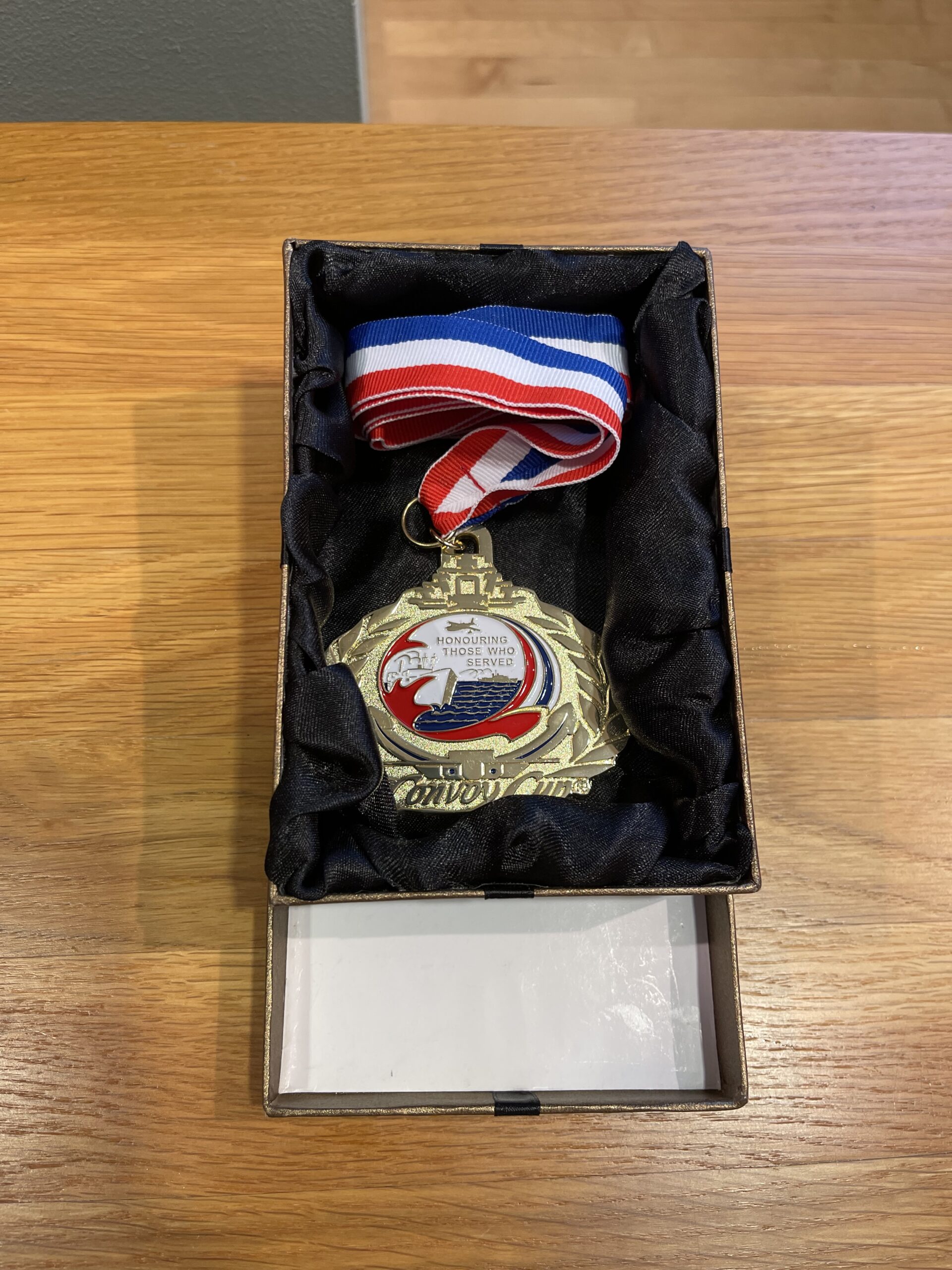William “Bill” Carlson and the M/S City of New York in WWII
Bill Carlson was a longtime member of Lodge # 12 of the International Ship Masters’ Association.

WWII NAVY ARMED GUARDSMAN WITNESSED LIFE AND DEATH DURING SINKING OF CITY OF NEW YORK
Reprinted from AMMV News summer 2016 edition
William Carlson of Duluth, MN was a member of the Navy Armed Guard aboard the dual passenger/cargo vessel M/S City of New York when it was torpedoed and sunk off Cape Hatteras on March 29, 1942. Carlson, who just turned 94 on July 4, is an active member of Lodge # 12 of the International Shipmasters’ Association and is well known within the local maritime community along the western shores of Lake Superior. His résumé includes various Engine Department ratings, a 100 ton USCG Master’s license, and extensive experience sailing on tall ships. What follows are the transcribed highlights from AMMV’s interview with Carlson. He spoke of his WWII service, including his recollections of the sinking of the City of New York and his knowledge of the “lifeboat baby”.
AMMV: What persuaded you to join the Navy? What can you tell us about your training and how you ended up on the City of New York?
Carlson: I joined the Naval Reserves in January 1940 because we got the pay of $7.50 every three months. We were mobilized on the third of November, 1940. We marched from the old Armory down to the depot (Duluth, MN) for the train to Chicago to catch the USS Paducah. We went up Lake Michigan and down Lake Huron, through the Welland Canal, Lake Ontario, and the St. Lawrence River to the Gulf of St. Lawrence, around Nova Scotia, past Cape Cod, and eventually to Brooklyn Navy Yard. We arrived there on the seventh of December 1940, exactly one year to the day before Pearl Harbor was attacked.
I asked to go through diesel school. So they sent me to New London, Connecticut for the summer for diesel school. Then I went back to the USS Paducah for Armed Guard gunnery school because I had been a gun trainer on Lake Michigan when I was 18, and that (information) was in my records. They were looking for gunners, even though I had been trained in diesel and had an Engine Room rating.
So (after training) we went on the City of New York with American-South African Lines.
AMMV: How long were you aboard the vessel prior to the attack, and what do you recall about the voyage?
Carlson: We headed out in January (1942) from New York City for South Africa. We hugged the coast of South America to stay away from the German raiders that were in the South Atlantic.
We went around the Cape of Good Hope and went up the coast to various towns, up as far as Portuguese, East Africa, of which Madagascar is off the coast. Then we loaded strategic supplies and goods for the States.
We carried 50 passengers, plus the (Merchant Marine) crew to take care of them. We made 14 knots with our diesel engines, so we ran by ourselves, zig-zagging.
AMMV: What can you tell us about the sinking and rescue efforts?
Carlson: We arrived off Cape Hatteras in a blow, and a submarine was waiting out there and hit us in the # 3 hold. The ship rolled a little bit to port and then straightened up. The Engineers stopped the engines. Passengers and crew started getting off in the lifeboats. I guess one lifeboat overturned. The seas were at least ten feet high.
As the passengers and crew were being loaded, we started firing the gun at the periscope. But every time a shell was fired, the waves covered up the periscope. When the waves dropped away, of course, it was still there. We fired probably ten shots or so with 4” shells. The sub pulled down his periscope, and put it up on the other side (of our ship). He fired another torpedo, this time into an after hold. We fired at the periscope at the same time from that side and they guys thought we might have hit it. Our gunnery officer then said, “Nothing more we can do here boys, so abandon ship”. I ran to our quarters and grabbed my pea coat and life jacket. I went down to the main deck but didn’t have to jump because the water was already up to my knees. I just stepped over the rail and then paddled out to the Bosun’s lifeboat. They were waiting for me and pulled me in. We were packed with 32 people in that lifeboat. We had to bail water out of the boat that night. The next day was calmer, and we put up the sails.
During the next night, I noticed a dark shape on the horizon. I shimmied up the mast and signaled S.O.S. with a flashlight, it was the only thing I knew. The shape turned out to be a WWI-era destroyer (USS Roper). It came alongside us and threw a cargo net over. I took the bow hook and held the boat to the net while the Bosun held the stern. Everyone crawled up the cargo net onto the destroyer, followed by us. Then they came up with tommy guns and shot the tanks so the lifeboat would not be left out floating.
During the blow that night, on another lifeboat, there was a wife of an attaché to the Yugoslav consulate who was pregnant. The ship’s doctor was in that boat. She had the baby in the bottom of the lifeboat during that storm! She named the baby Jesse Roper Mohorovicic after the USS Roper. That was quite interesting!
AMMV: Were you awake at the time when the ship was hit by the first torpedo?
Carlson: We had just finished dinner, so I was glad we had something to eat!
AMMV: Did you know right away what happened, and what were you thinking?
Carlson: You bet we knew it! All I was thinking was we better get to the gun and start firing!
AMMV: Was your lifeboat crew discovered and picked-up before or after the lifeboat with the woman and her newborn baby?
Carlson: Before.
AMMV: What did you do immediately upon boarding the Roper?
Carlson: I went down below into the Fireroom to get warm.
AMMV: What do you recall about fellow Armed Guardsman John McInnus, Jr., also from Duluth, who unfortunately didn’t make it?
Carlson: He was with our crew and I guess he had given his jacket to a woman who was in the lifeboat and he ended up dying of exposure. We didn’t know it at the time cause that boat wasn’t picked up until 16 days later.
AMMV: What did the Navy do with your Armed Guard gang following the sinking?
Carlson: We went into Norfolk and got off, and I went home on 30 days leave. I heard that our crew’s next trip was Murmansk. I knew the German subs were below and the bombers were overhead. I asked them to put me in the sub chaser fleet, so that’s where I went.
AMMV: When did you get out of the Navy?
Carlson: October 1, 1945. Then I was in the Reserves from January 1946 until 1948.
AMMV: Did you follow the story of the lifeboat baby after the sinking?
Carlson: Well, I had always thought Jesse was a girl. I didn’t know any different until I read in a Legion newsletter or something, at least 20 years after, that the Roper was having a reunion and “he” was invited.
AMMV: With your training and experience, did you ever switch over to the Merchant Marine?
Carlson: I went down to the Lake Carriers’ Association and took an exam. They assigned me to the S/S Sylvania as an Oiler. I stood watch with the First Assistant Engineer. I was gone for three months and my kids didn’t know who I was when I returned! So I told the Captain that I’m getting off to find a job ashore so I can be with my family. Then I worked with Cummins Diesel for 30 years.
Photos (L to R): Clipping from Duluth, MN newspaper following Carlson’s return home after sinking of M/S City of New York; brochure from American South African Lines (later Farrell Lines); Carlson at his Duluth home (2016)



Photos (L to R): Carlson honored at AMMV National Convention on March 29, 2017 (75th anniversary of sinking of M/S City of New York), receiving Congressional recognition from the office of Nevada Senator Dean Heller and the “American Legacy Recognition” plaque from AMMV. At the far right of group photo are the grandson and son of Dr. Len Conly, who delivered the Lifeboat Baby. The image on far right is the WWII Navy Armed Guard logo.


Navy Armed Guardsmen recognized at Convoy Cup ceremony in Minneapolis
Reprinted from the AMMV News summer 2021 edition
On June 18, at the Honorary Consulate of Norway in Minneapolis, WWII Navy Armed Guard Veteran William Carlson was awarded the Convoy Cup medallion and certificate.
Carlson was aboard the M/S City of New York when it was torpedoed off Cape Hatteras on 3/29/1942. The bravery and quick response of the Armed Guard crew, as they fired back at the attacking U-boat, bought time for passengers and crew to abandon ship.
In one of the crowded lifeboats, a pregnant passenger gave birth, at night, in a storm. The ship’s physician, documented U.S. Merchant Mariner Dr. Len Conly, delivered the baby after breaking his own ribs trying to embark the lifeboat as the second torpedo slammed into the City of New York. The Lifeboat Baby, Jesse Roper Mohorovicic, became known as the “baby Hitler couldn’t get”, and the amazing miracle of birth at sea in the face of imminent death was broadcast around the world to boost the morale of Allied troops.
In attendance were members of the International Ship Masters’ Association (Twin Ports Lodge # 12), family and close friends of Carlson, Honorary Consul Eivind J. Heiberg, Vice Consul Britt Ardakani, Consular Officer Ragnhild Hjeltnes, and representing AMMV was Past National President Capt. Christopher Edyvean. Fox Channel 9 News Minneapolis also documented the event.
Photos: (L to R): Carlson with Honorary Consul Eivind J. Heiberg; Convoy Cup Medallion; lower: M/S City of New York


